
Reading Fluency Info and Strategies for MS Teachers
- Subject:
- Education
- Material Type:
- Teaching/Learning Strategy
- Author:
- Jami Daniel
- Date Added:
- 03/22/2021

Reading Fluency Info and Strategies for MS Teachers
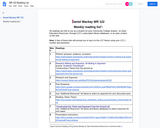
Reading list of open/free materials to support Argument, Research and Multimodal Composition course.
Course description:
WR 122 continues the focus of WR 121 in its review of rhetorical concepts and vocabulary, in the development of reading, thinking, and writing skills, along with metacognitive competencies understood through the lens of a rhetorical vocabulary. Specifically, students will identify, evaluate, and construct chains of reasoning, a process that includes an ability to distinguish assertion from evidence, recognize and evaluate assumptions, and select sources appropriate for a rhetorical task. Students will employ a flexible, collaborative, and appropriate composing process, working in multiple genres, and utilizing at least two modalities. They will produce 3500-4500 words of revised, final draft copy or an appropriate multimodal analog for this amount of text. Students will produce at least one essay of a minimum of 1500 words, demonstrating competence in both research and academic argumentation.
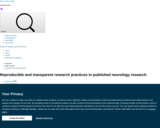
The objective of this study was to evaluate the nature and extent of reproducible and transparent research practices in neurology publications. Methods The NLM catalog was used to identify MEDLINE-indexed neurology journals. A PubMed search of these journals was conducted to retrieve publications over a 5-year period from 2014 to 2018. A random sample of publications was extracted. Two authors conducted data extraction in a blinded, duplicate fashion using a pilot-tested Google form. This form prompted data extractors to determine whether publications provided access to items such as study materials, raw data, analysis scripts, and protocols. In addition, we determined if the publication was included in a replication study or systematic review, was preregistered, had a conflict of interest declaration, specified funding sources, and was open access. Results Our search identified 223,932 publications meeting the inclusion criteria, from which 400 were randomly sampled. Only 389 articles were accessible, yielding 271 publications with empirical data for analysis. Our results indicate that 9.4% provided access to materials, 9.2% provided access to raw data, 0.7% provided access to the analysis scripts, 0.7% linked the protocol, and 3.7% were preregistered. A third of sampled publications lacked funding or conflict of interest statements. No publications from our sample were included in replication studies, but a fifth were cited in a systematic review or meta-analysis. Conclusions Currently, published neurology research does not consistently provide information needed for reproducibility. The implications of poor research reporting can both affect patient care and increase research waste. Collaborative intervention by authors, peer reviewers, journals, and funding sources is needed to mitigate this problem.

In this seminar, students will design and perfect a digital environment to house the activities of large-scale organizations of people making bottom-up decisions, such as with citizen-government affairs, voting corporate shareholders or voting members of global non-profits and labor unions. A working Open Source prototype created last semester will be used as the starting point, featuring collaborative filtering and electronic agent technology pioneered at the Media Lab. This course focuses on development of online spaces as part of an interdependent human environment, including physical architectures, mapped work processes and social/political dimensions.
A cross-disciplinary approach will be taken; students with background in architecture, urban planning, law, cognition, business, digital media and computer science are encouraged to participate. No prior technical knowledge is necessary, though a rudimentary understanding of web page creation is helpful.

Vigas en estructuras metalicas y su analisis Carrera de ingenieria Civil del centro Universitario San Marcos de la Universidad San Carlos de Guatemala

Resumo do projeto
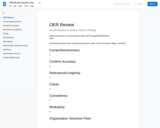
Review of An Introduction to Heat & Cold as Therapy: https://docs.google.com/document/d/1-aGYKUblkEavmmWffXx1HRrIF2S4j9wGg_4N-zQISbE/edit#heading=h.su29wyexivwo
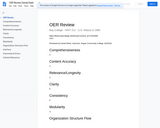
Review of Bay College - HIST 211 - U.S. History to 1865
https://drive.google.com/open?id=187ertrtIcZ66yYHxh-wlg5bPzBb8fI_J5uKKsZKHe1Y
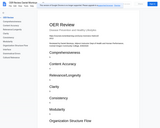
Review of Disease Prevention and Healthy Lifestyles
https://drive.google.com/open?id=11lpay5-E75noIMq2Bok5rD0Z2FjiHSaJcMFKVLewkbg
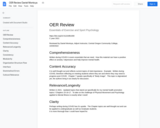
Link here: https://doi.org/10.51224/B1000
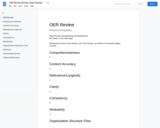
Review of Physical Geography: https://drive.google.com/open?id=1zpexvDtNw3GMFVRhGBrGhIbXwZo31QWNENTcaoexbss
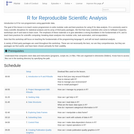
This lesson in part of Software Carpentry workshop and teach novice programmers to write modular code and best practices for using R for data analysis. an introduction to R for non-programmers using gapminder data The goal of this lesson is to teach novice programmers to write modular code and best practices for using R for data analysis. R is commonly used in many scientific disciplines for statistical analysis and its array of third-party packages. We find that many scientists who come to Software Carpentry workshops use R and want to learn more. The emphasis of these materials is to give attendees a strong foundation in the fundamentals of R, and to teach best practices for scientific computing: breaking down analyses into modular units, task automation, and encapsulation. Note that this workshop will focus on teaching the fundamentals of the programming language R, and will not teach statistical analysis. The lesson contains more material than can be taught in a day. The instructor notes page has some suggested lesson plans suitable for a one or half day workshop. A variety of third party packages are used throughout this workshop. These are not necessarily the best, nor are they comprehensive, but they are packages we find useful, and have been chosen primarily for their usability.

Syllabus and assignments for a First-Year Writing Course. I think there's enough in this document for you to run this class if you wanted to!
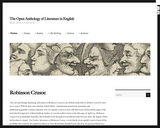
The Life and Strange Surprizing Adventures of Robinson Crusoe is one of those books that we all know even if we have never read it. With his first work of fiction, Daniel Defoe–a businessman turned poet, journalist, and political propagandist–created a character who very quickly went on to have a life that went well beyond the pages of the book that first appeared, without build-up, fanfare, or even the author’s name on the title page, in April 1719. Robinson Crusoe was an immediate bestseller; the bookseller went through several editions in the first year alone. By August, Defoe had produced a sequel, The Farther Adventures of Robinson Crusoe, a work that he wrote quickly in part to head off the possibility that someone else might beat him to it. Over the last three hundred years, the story of a person isolated on a deserted island or something like it, has been used by dozens, maybe hundreds of writers, who have made it a genre of its own, the “Robinsoniad,” a genre that includes satirical parodies like Gulliver’s Travels, children’s books like The Swiss Family Robinson, Bugs Bunny cartoons, television situation comedies like Gilligan’s Island, and science fiction works like The Martian. Robinson Crusoe, the man and the book in which he first appeared, has become one of the foundational myths of the modern world.The story of one man’s survival has become so well known in all of these instances that it can be difficult to see through the mythology to analyze Defoe’s original book and to imagine what its first readers might have noticed and found so striking. It is important to recognize, for example, that the book is told in the first person, by a narrator who never lets on that this is a work of fiction. Defoe’s name, as noted above, did not appear on the title page of the first edition (although it quickly became clear to those in the know that he was the author), or even in any of the many editions issued in his lifetime. Although the book is famous for the many years that Crusoe spends on the island, it takes a while for him to get there, and his experiences both before and after his time there are worth paying attention to for the way that they frame the central experience. Defoe’s prose is sometimes clunky-he has a tendency to shape sentences and paragraphs that would never pass muster with a modern copyeditor–but it is also capable of great beauty and insight, and rewards careful attention.

This course was created for the “product development” track of MIT’s System Design and Management Program (SDM) in conjunction with the Center for Innovation in Product Development. After taking this course, a student should be able to:
Formulate measures of performance of a system or quality characteristics. These quality characteristics are to be made robust to noise affecting the system.
Sythesize and select design concepts for robustness.
Identify noise factors whose variation may affect the quality characteristics.
Estimate the robustness of any given design (experimentally and analytically).
Formulate and implement methods to reduce the effects of noise (parameter design, active control, adjustment).
Select rational tolerances for a design.
Explain the role of robust design techniques within the wider context of the product development process.
Lead product development activities that include robust design techniques.
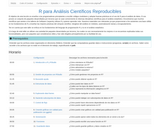
Una introducción a R utilizando los datos de Gapminder. El objetivo de esta lección es enseñar a las programadoras principiantes a escribir códigos modulares y adoptar buenas prácticas en el uso de R para el análisis de datos. R nos provee un conjunto de paquetes desarrollados por terceros que se usan comúnmente en diversas disciplinas científicas para el análisis estadístico. Encontramos que muchos científicos que asisten a los talleres de Software Carpentry utilizan R y quieren aprender más. Nuestros materiales son relevantes ya que proporcionan a los asistentes una base sólida en los fundamentos de R y enseñan las mejores prácticas del cómputo científico: desglose del análisis en módulos, automatización tareas y encapsulamiento. Ten en cuenta que este taller se enfoca en los fundamentos del lenguaje de programación R y no en el análisis estadístico. A lo largo de este taller se utilizan una variedad de paquetes desarrolados por terceros, los cuales no son necesariamente los mejores ni se encuentran explicadas todas sus funcionalidades, pero son paquetes que consideramos útiles y han sido elegidos principalmente por su facilidad de uso.
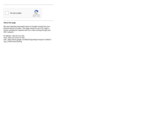
Este material nos apresenta a cultura Baniwa, promovendo um estudo do mundo indígena a partir de suas percepções, modos de vida, e de seus saberes agroecológicos guiados e respeitados por algumas famílias desta cultura. A jornada desses registros sob uma ótica Baniwa, tem como intuito a elaboração e aplicabilidade de um Calendário Etnoagroecológico em um contexto escolar local para que os estudantes indígenas das disciplinas de Geografia e Ciências possam compreender seu papel como guardiões de sua própria cultura resgatando e preservando os saberes tradicionais de seus antepassados.
Cada constelação apresentada explica os acontecimentos de reprodução e migração de peixes, aves e animais, período de floração de frutas nativas ou da florestas e das planas cultivadas, entre outros. Com essas informações nossos antepassados protegiam nossas florestas e rios, aproveitando sabiamente do que ocorre em cada estação. Estes saberes sagrados permitem conhecer a importância dos elementos materiais e imateriais que configuram o manejo da cultura relacional de grupos amazônicos, com sua vivências e usos patrimoniais coletivo da riqueza cultural da terra como sistema de produção na aldei
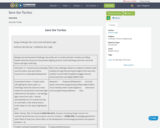
Save the Turtles

Download and print this colorful "Science Inquiry Map" Poster featuring the web of inquiry processes as described by the Five Essential Features of Inquiry from the National Science Education Standards. In addition, the model of inquiry described by the Five Essential Features aligns directly with the Science Practices described in the Next Generation Science Standards. Generally, this poster is used by elementary and middle-school teachers to support learners in being metacognitive about what science practices are in the foreground of their current work during an investigation.
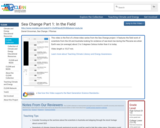
This video is the first of a three-video series from the Sea Change project. It features the field work of scientists from the US and Australia looking for evidence of sea level rise during the Pliocene era when Earth was (on average) about 2 to 3 degrees Celsius hotter than it is today.